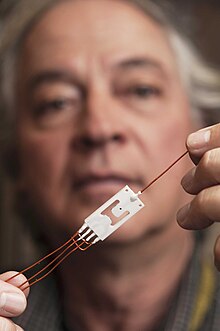
Back مولد نيترونات Arabic Generador de neutrons Catalan Neutrongenerator Danish Generador de neutrones Spanish مولد نوترون Persian Générateur de neutrons French Neutronski generator Croatian Generatore neutronico Italian 中性子源 Japanese Generator neutronów Polish
This article needs additional citations for verification. (July 2016) |
| Nuclear physics |
|---|
 |

Neutron generators are neutron source devices which contain compact linear particle accelerators and that produce neutrons by fusing isotopes of hydrogen together. The fusion reactions take place in these devices by accelerating either deuterium, tritium, or a mixture of these two isotopes into a metal hydride target which also contains deuterium, tritium or a mixture of these isotopes. Fusion of deuterium atoms (D + D) results in the formation of a helium-3 ion and a neutron with a kinetic energy of approximately 2.5 MeV. Fusion of a deuterium and a tritium atom (D + T) results in the formation of a helium-4 ion and a neutron with a kinetic energy of approximately 14.1 MeV. Neutron generators have applications in medicine, security, and materials analysis.[1]
The basic concept was first developed by Ernest Rutherford's team in the Cavendish Laboratory in the early 1930s. Using a linear accelerator driven by a Cockcroft–Walton generator, Mark Oliphant led an experiment that fired deuterium ions into a deuterium-infused metal foil and noticed that a small number of these particles gave off alpha particles. This was the first demonstration of nuclear fusion, as well as the first discovery of Helium-3 and tritium, created in these reactions. The introduction of new power sources has continually shrunk the size of these machines, from Oliphant's that filled the corner of the lab, to modern machines that are highly portable. Thousands of such small, relatively inexpensive systems have been built over the past five decades.
While neutron generators do produce fusion reactions, the number of accelerated ions that cause these reactions is very low. It can be easily demonstrated that the energy released by these reactions is many times lower than the energy needed to accelerate the ions, so there is no possibility of these machines being used to produce net fusion power. A related concept, colliding beam fusion, attempts to address this issue using two accelerators firing at each other.

- ^ Reijonen, J. "Compact Neutron Generators for Medical, Homeland Security, and Planetary Exploration" (PDF). Proceedings of 2005 Particle Accelerator Conference, Knoxville, Tennessee: 49–53.
© MMXXIII Rich X Search. We shall prevail. All rights reserved. Rich X Search